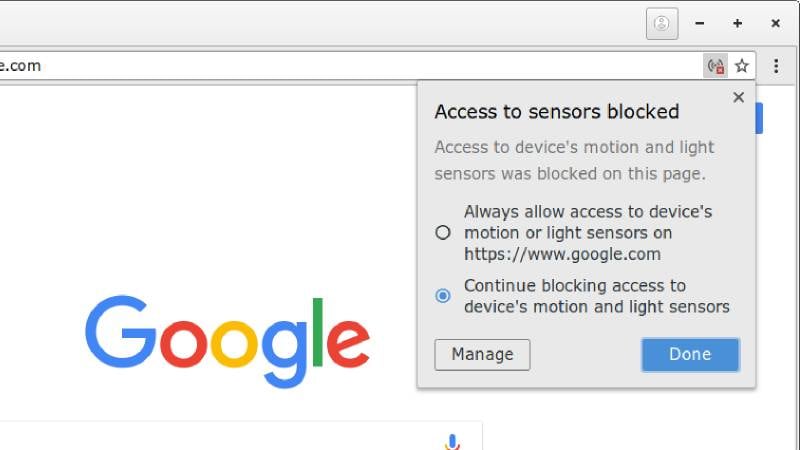- Home
- Internet
- Internet News
- Google Chrome Will Prevent Websites From Using Your Devices’ Motion Sensors to Track You
Google Chrome Will Prevent Websites From Using Your Devices’ Motion Sensors to Track You

Photo Credit: bugs.chromium.org
A new feature spotted in a developer version of Google Chrome, which will eventually be incorporated into a future release of the browser, allows users to block websites from accessing their devices' motion sensors, gyroscopes, and ambient light sensors. This new measure has been incorporated across desktop and Android versions of Chrome to help protect users' privacy. Studies have shown that data from these sensors can be used to track whether users are moving or still, whether they're in a vehicle, and how often they move.
Combined with browsing habits and other information that Web developers are allowed to collect, motion sensor data can be used to identify unique patterns that tie specific users to their devices and allow them to be tracked and fingerprinted online. According to one academic study cited by MSPowerUser, the minute individual variations and imperfections in sensor hardware can also be used to identify and correlate data to specific users in what is called a “highly accurate” mechanism.
The change has been discussed in Google's Chromium developers' message boards and was spotted by Techdows. Google hopes to improve user privacy by allowing users to decide which websites can and cannot access such data. The latest build of Google Chrome Canary, a alerts users when a website is trying to access these sensors, in much the same way as the browser currently requests permission for microphone, camera, and GPS data. By default though, access is allowed.
The desktop version of Chrome Canary lets users decide which sites to whitelist or blacklist, but as of now the Android version only has a simple toggle control that governs behaviour for all websites. The feature is targeted for release with Chrome 75, whereas the current stable release of Chrome across platforms is Chrome 73.
Chrome Canary is an unstable development channel which is refreshed nearly every day so that new features can be tested. It is generally considered risky for use as anything other than development experiments, as these features are added without much testing. In order to test the sensor blocking features, Chrome Canary users can go to chrome://settings/content/sensors. Another recent change spotted in Chrome Canary is a dark mode for rendering websites.
Get your daily dose of tech news, reviews, and insights, in under 80 characters on Gadgets 360 Turbo. Connect with fellow tech lovers on our Forum. Follow us on X, Facebook, WhatsApp, Threads and Google News for instant updates. Catch all the action on our YouTube channel.
Related Stories
- Samsung Galaxy Unpacked 2025
- ChatGPT
- Redmi Note 14 Pro+
- iPhone 16
- Apple Vision Pro
- Oneplus 12
- OnePlus Nord CE 3 Lite 5G
- iPhone 13
- Xiaomi 14 Pro
- Oppo Find N3
- Tecno Spark Go (2023)
- Realme V30
- Best Phones Under 25000
- Samsung Galaxy S24 Series
- Cryptocurrency
- iQoo 12
- Samsung Galaxy S24 Ultra
- Giottus
- Samsung Galaxy Z Flip 5
- Apple 'Scary Fast'
- Housefull 5
- GoPro Hero 12 Black Review
- Invincible Season 2
- JioGlass
- HD Ready TV
- Laptop Under 50000
- Smartwatch Under 10000
- Latest Mobile Phones
- Compare Phones
- Xiaomi 17 Ultra Leica Edition
- Xiaomi 17 Ultra
- Huawei Nova 15
- Huawei Nova 15 Pro
- Huawei Nova 15 Ultra
- OnePlus 15R
- Realme Narzo 90x 5G
- Realme Narzo 90 5G
- Asus ProArt P16
- MacBook Pro 14-inch (M5, 2025)
- OPPO Pad Air 5
- Huawei MatePad 11.5 (2026)
- Huawei Watch 10th Anniversary Edition
- OnePlus Watch Lite
- Acerpure Nitro Z Series 100-inch QLED TV
- Samsung 43 Inch LED Ultra HD (4K) Smart TV (UA43UE81AFULXL)
- Asus ROG Ally
- Nintendo Switch Lite
- Haier 1.6 Ton 5 Star Inverter Split AC (HSU19G-MZAID5BN-INV)
- Haier 1.6 Ton 5 Star Inverter Split AC (HSU19G-MZAIM5BN-INV)

















